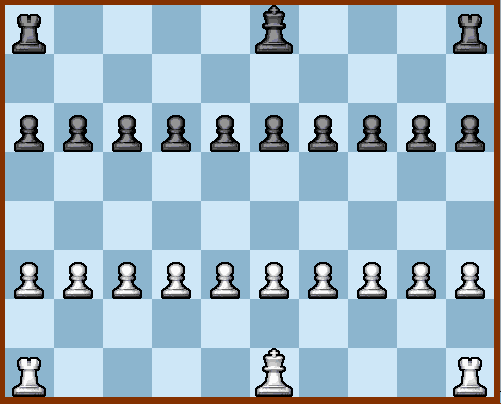

In Scandinavian Chess pieces move as in orthodox chess, with the exception of the two additional pieces deriving from Capablanca's Chess. These are the Archbichop (which combines the moves of Bishop and Knight) and the Chancellor (which combines the moves of Rook and Knight). The pawns move as in orthodox chess, but have no initial double move. As the pawns are all located on the third rank, they can reach the fourth rank immediately anyway. When castling, the King jumps three squares instead of two. Promotion rules are the same as in orthodox chess (with the addition of Archbishop and Chancellor).
In the first phase the players take turns to drop pieces on the board, either behind the pawn chain, or on a friendly pawn. In the latter case the removed friendly pawn must immediately be relocated to another empty position, that is, somewhere on the second rank. The two Bishops must be dropped on different colours. The King and Rooks are initially placed on their standard positions. They are immobile until all pieces have been dropped. After all the pieces have been dropped the play begins.
Scandinavian Chess was invented and implemented by undersigned, April 2006. Inspirational sources are Swedish Chess and Capablanca's Chess. The piece set is the same as in Capablanca's Chess.
There exists an alternative variant of Scandinavian Chess where all pieces, except pawns, are exterior. In this case castling doesn't exist, and the Rooks must be dropped on the first rank. The following image is an example.
 Example of opening position after all pieces have been dropped and pawns relocated. White can now begin by playing f3-f4, for instance.
Example of opening position after all pieces have been dropped and pawns relocated. White can now begin by playing f3-f4, for instance.
Chess variants featuring big boards have been invented before, most notably Tamerlane Chess, allegedly invented by Timur Lenk, C. Freeling's Grand Chess, and Capablanca's chess, invented by the former world champion. In Scandinavian Chess the initial drop move, deriving from Burmese Chess, allows great strategical freedom. The king can achieve a protected position while the pawns can be relocated to protect the king. This significantly affects the balance between strategy and tactics. Opening play does not rely on concrete variants but rather on principles and favoured piece setups. Consequently the game will never be bogged down by opening theory, as the case is in today's orthodox chess.
Always give your King a protected position, preferably near the corner. You can relocate the pawns so that they protect the King. Remember that relocated pawns have no initial double move, so it takes longer to activate such pawns. In the opening phase, the same pawn can be relocated several times, by dropping pieces on it. Keep the pawns in the centre, because centre pawns are valuable. Look for ways to exchange lower valued pieces for larger valued ones.
(Don't miss my other chess variants.)
You can download my free Scandinavian Chess program here (updated 2006-05-11), but you must own the software Zillions of Games to be able to run it.
© M. Winther 2006